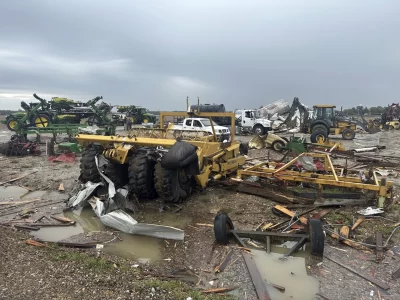
It’s still spring in Brazil, but a dangerous heat wave is sweeping across large swathes of the country, forcing Rio de Janeiro’s vendors off the streets due to health alerts and driving up energy demand amid reports of power outages.
Most Brazilian states face “great danger” from the heat, according to the National Institute of Meteorology. The institution issued a red alert for the center-west, southeast and parts of the north warning of “a high probability of major damage and accidents, with risks to physical integrity or even human life.”
The heat index — a combination of temperature and humidity — hit 58.5 degrees Celsius (137 Fahrenheit) Tuesday morning in Rio, the highest index ever recorded there. Actual temperatures dropped slightly on Wednesday, but were forecast to rise again to 40 degrees Celsius (104 F) on Thursday.
Cariocas — as residents of Rio are known — have always seen sun, heat and the beach as part of their identity, said Núbia Beray, coordinator of Rio de Janeiro Federal University’s GeoClima laboratory. But this is too much even for many of them, she said.
“Cariocas come home from work in buses without air conditioning. Street vendors cannot work because they sometimes faint. The heat kills,” Beray said.
“Maximum 39°C and it’s not even summer yet,” Rio’s city hall said Tuesday on X, formerly Twitter. The mayor’s office recommended eating fruit and vegetables and keeping an umbrella handy for shade.
In Sao Paulo, temperatures reached 37.7 degrees Celsius (99.9 F), just short of a record, according to meteorology company MetSul. Mato Grosso do Sul state, in the nation’s interior, recorded 43 degrees Celsius (109.4 F) last week — the record for actual temperature during this heat wave, according to the country’s institute of meteorology, known by the Portuguese acronym Inmet.
Brazilians turned to fans, air conditioners and dehumidifiers to cool down, with utilities reporting record energy demand. Power outages were reported in Sao Paulo and Rio de Janeiro.
Amid the high heat, wildfires are burning widely in the Pantanal biome, the world’s biggest tropical wetlands spanning parts of Mato Grosso and Mato Grosso do Sul states. The fires have ravaged an area about the size of Cyprus, or more than 947,000 hectares (about 3,600 square miles), according to the Environmental Satellite Applications Laboratory of the Federal University of Rio de Janeiro.
Temperatures across South America are affected by the climate phenomenon El Niño, a periodic naturally occurring event that warms surface waters in the Equatorial Pacific region. But this year, ocean temperature rose extremely quickly – in a couple of months, said Danielle Ferreira, a climatologist at Inmet.
“This indicates that the impacts are accelerating,” Ferreira said.
In Brazil, El Niño has historically caused droughts in the north and intense rainfall in the south, Ferreira said. This year, the impacts of the climate event have been particularly dramatic.
In the Amazon rainforest, the drought has been so severe communities dependent on the dried-up waterways are stranded without supply of fuel, food or filtered water. And in Brazil’s southern state of Rio Grande do Sul, devastating floods killed dozens.
Scientists say extreme weather is happening more frequently due to human-caused climate change.
Heat waves have become seven times more frequent in the past seven decades, according to a study published this week by the National Institute for Space Research, a federal agency. The current one is the eighth to hit Brazil this year.
For the first time ever, the country now has a region that has the characteristics of a desert — in the northeastern Bahia state, a study from the federal agency showed this month.
As global temperatures rise, water evaporates more rapidly. Desertification, as this phenomenon is known, is also advancing in other regions, said one of the authors of the study, hydrologist Javier Tomasella.
“We have never seen anything like it,” Tomasella said.







